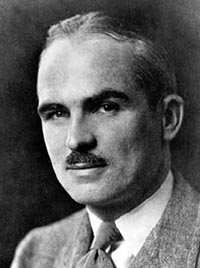
Chauncey (Chance) Milton Vought (1890 - 1930)
The story of Vought Aircraft Company begins with Chance Vought, the man. Chauncey (Chance) Milton Vought was born to George Washington and Annie E. Vought, on February 26, 1888 on Long Island, New York. His parents had a successful business designing and building quality sailing boats but little is known of Chauncey's early childhood except that he had displayed an early talent for mechanical things.
Chance Milton Vought was only fifteen years old when Orville Wright, on the morning of December 17, 1903, became the first man to officially pilot and fly a heavier-than-air machine. Young Chance's reaction to this historical event has not been recorded but we know that it must have greatly influenced his engineering studies and thinking. His elementary school education was in the New York Public School System and, upon graduation he entered the Pratt Institute of Brooklyn. He transferred later to New York University, where he specialized in the study of the internal combustion engine, and then transferred to the University of Pennsylvania in search of better engineering courses. Several sources suggest that he was making a worthy study of aeronautical engines, an interesting note because, for the most part, the American public in 1910 was not interested in aviation activities. A superb student, he was usually ahead of his class in the theory and principles of engineering. Chance left school in 1910 to work for Harold McCormick an early aviation backer who was president of McCormick Reapers. The first aircraft that Chance Vought was associated with was the McCormick-Romme "Umbrella" plane which flew on March 11, 1910. He learned to fly from Max Lillie in 1912 using a Wright biplane and received FAI pilots certificate number 156. It was on this certificate that he signed his name Chance M. Vought rather than the printed name Chauncey M. Vought. This was the first official indication that Chauncey preferred the name "Chance". He became an aeronautical engineer and instructor pilot for the Max Lillie School of Aviation in 1913 and was involved in the design of the Lillie-Vought tractor biplane. While at Lillie he also edited the pioneer American aviation weekly, "Aero and Hydro". Having developed some sound and unique ideas on airplane design, Vought went to work at the Mayo Radiator Works. His first aircraft design, the Mayo-Vought Simplex was built in 1914, and first flew in May of 1915. It was used by the British as a WW I pilot trainer. Vought worked for Curtiss briefly in 1915 as a consulting engineer for flying boats. In the fall of 1916 he became chief engineer at the Wright Company of Dayton, Ohio. In 1916 the Wright Company and The Glenn L. Martin Company merged to form The Wright-Martin Aircraft Corporation. During his brief tenure there, the Wright-Martin Model V was produced; the first flight of the Model V was in September 1916. Vought was sent to Europe to survey the tactical employment of airplanes and the impact of the war on their design.When the United States entered World War I in April of 1917, the country was basically unprepared for war, especially so in military aviation. The American airplane industry was ignorant of combat airplane technology, since any advancements in the state-of-the-art were jealously guarded by the various combatants. Therefore, the decision was made for America to concentrate on building training airplanes and purchasing combat airplanes from the Allies. The need for trainers became pressing, and contracts were awarded to many inexperienced firms. With his past experience on several designs and his sporting nature, Chance Vought joined with Birdseye Lewis to form a company and take advantage of the trainer aircraft opportunities. The company was formed as the Lewis and Vought Corporation on June 18, 1917. The company, under various names, has been in continuous operation since then and is the second oldest airframe manufacturer in the United States. (The Boeing Company was the first.) Chance Milton Vought died unexpectedly on July 25, 1930 from septicemia (blood poisoning) at the age of 42. Even though he did not live to see many of them, more than 15,000 aircraft and Missiles bearing the Vought name have been built since 1917.
The McCormick-Romme 'Umbrella' airplane Designed and built by William S. Romme, with funding from Harold McCormick and John D. Rockefeller, Jr. Chance Vought was a design engineer on this aircraft from 1910 to 1913
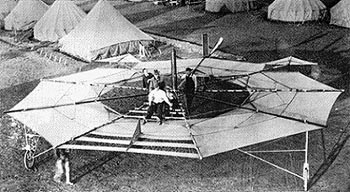 The McCormick-Romme 'Umbrella' airplane, Elevated view, c.1911 Chance Vought was a design engineer on this aircraft from 1910 to 1913
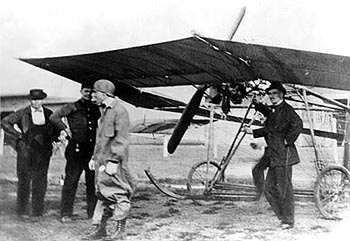 The McCormick-Romme 'Umbrella' airplane, San Antonio, Texas, 1911 Chance Vought was a design engineer on this aircraft from 1910 to 1913 and can be seen seen at the right under the wing. The pilot, Andrew Drew, in flight coveralls
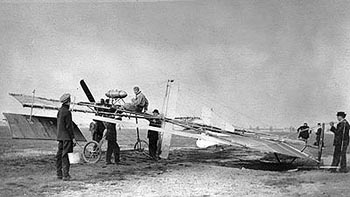 The McCormick-Romme 'Umbrella' airplane preparing for a test flight, c.1911 Chance Vought was a design engineer on this aircraft from 1910 to 1913
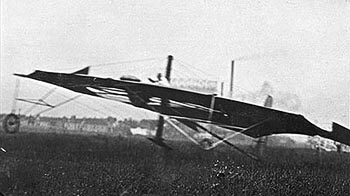 The McCormick-Romme 'Umbrella' airplane taking off from a field in San Antonio, Texas, c.1911 Chance Vought was a design engineer on this aircraft from 1910 to 1913
Chance Vought's first association with aircraft engineering was with the McCormick-Romme, "Umbrella" plane in 1910. In 1912 he learned to fly from Max Lillie in a Wright biplane and received FAI pilots certificate number 156. He became an aeronautical engineer and instructor pilot for the Max Lillie School of Aviation. While there he was involved in the design of an aircraft of Lillie's requirements.
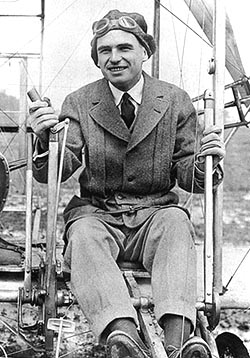 Chance Vought in Max Lillie's Wright B. Biplane
He went on to work as an aeronautical engineer for several other aircraft manufactures, including the Mayo Radiator Works, Curtiss, the Wright Company and the Wright-Martin Company, designing some unique and excellent aircraft. After the United States entered WW I in April of 1917, Chance Vought decided to take advantage of the trainer aircraft opportunity. In June of 1917, with the help of Birdseye Lewis, Vought formed the Lewis and Vought Corporation to build pilot trainer aircraft for the U.S armed forces. The company, under various names, has been in continuos operation since then and is the second oldest airframe manufacturer in the United States (Boeing Company was the first). Chance Vought died unexpectedly on July 25, 1930 at the age of 42, from septicemia (blood poisoning).
Chauncey (Chance) Milton Vought Chance Milton Vought was a pioneer airplane engineer, designer and visionary whose contributions to early-day Naval aviation place him among the founders of the modern aerospace industry. Born on February 26, 1890, in New York City, Vought studied engineering at the Pratt Institute, New York University and the University of Pennsylvania. A superb student, he was usually ahead of his class in theory and principles of engineering. He left school in 1910 to work for Harold F. McCormick, president of McCormick Reapers, an early aircraft backer. He learned to fly from the Wright Brothers in 1911 and in eight months, received FAI pilot's certificate No. 156. He became an aeronautical engineer and pilot for the Max Lillie School of Aviation in 1913. While at Lillie, he also managed time to edit the pioneer American aviation weekly, "Aero & Hydro." Having developed some sound and unique ideas on how to design an airplane, Vought went to work at the Mayo Radiator Works. His first aircraft design, the Mayo-Vought-Simplex, was built in 1914 and used by the British as a World War I pilot training plane. In 1916 Vought was approached by the Wright Company of Dayton to join them long term as chief engineer. Chance declined a contract, stating that he would not be legally bound to anyone, but worked there for a short time. During his brief tenure at Wright, he produced the then famous Model V Wright flyer. On June 18, 1917, Chance Vought and Birdseye Lewis formed the Lewis & Vought Corporation to design, build and sell their own aircraft. At Lewis & Vought, Chance quickly set about perfecting his design for a standardized military training plane. The company's first product was the VE-7 and it met with the highest approval of the war department. General Billy Mitchell saluted Vought's efforts by saying that the Vought machine had all the air qualities of a single seat chasse machine, able to out maneuver almost anything in the air. Vought personally designed, supervised and approved every phase of the trainers' construction. Vought and then LCdr Marc Mitscher are shown here, acting as judges in the New York Toronto Air Race in which the VE-7 won the training handicap event against a field of thirty competitors. A contemporary described Vought as one of the outstanding designers in the United States in the 1920's whose work was characterized by advanced thought, sound and finished construction, clean lines and attractive appearance. He became interested in the specialized problems of Naval aviation and suggested to the Navy the Wasp-size engine, which it ordered from Pratt and Whitney. As a division of United Aircraft and Transportation Corporation in the 1920's, the Vought company prospered. When the USS Langley was refitted from an overall collier into the first aircraft carrier, it was a Vought VE-7, fitted with a crude arresting hook, that made Naval aviation history in 1922. The Vought UO-l gave the Navy its first catapult launched aircraft. Introduced to the fleet a year later, they were quickly assigned to every battleship and cruiser then in service. Later, Chance Vought diligently set about designing an aircraft that would combine the best of the features available to aviation science. The result was the 02U-1, the first Corsair. The Corsair's tactical flexibility rapidly earned it the reputation as a jack-of-all-trades. They could be flown on wheels from an aircraft carrier as a defensive fighter, catapulted as an amphibian from battleships and cruisers and land on carriers for reservicing. In all, over 500 02U variants were built for the Navy and export. More than 15,000 military aircraft were built bearing the Vought name, including the 02U Corsair of 1928, the F4U "Bentwing" Corsair of World War II fame, the F-8 Crusader and today's A-7 attack aircraft. Chance Vought had realized his boyhood dream. He had founded a company that reflected his own strict creative discipline and in so doing won the respect of his aviation fellows and the American people. In wane years of economic strife his company showed continued growth. In spite of numerous mergers and transi-tions, LTV Aircraft Products Group remains one of the leading members of the aerospace industry and LTV is the second oldest aircraft company in existence today. The tremendous success of the company and its famous airplanes from the 1930's on was, unfortunately, not seen by its founder. Chance Vought died unexpectedly at the age of 40 from septicemia, or blood poisoning, July 25, 1930. His death came just two days after that of fellow aviation pioneer Glenn Curtiss. Copyright © 1997 by NAHF. All Rights Reserved.
|
© Copyright 1999-2002 CTIE - All Rights Reserved - Caution |
